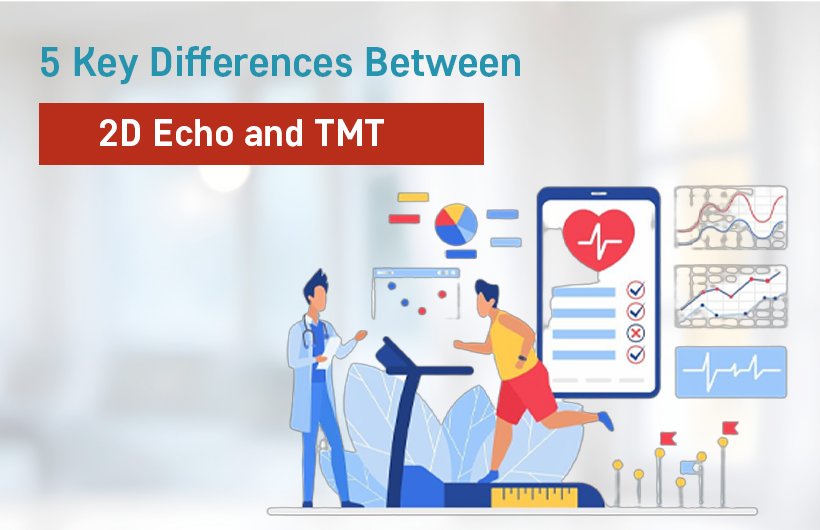When it comes to heart care, early and accurate diagnosis is crucial. Health systems provide multiple tests for heart disease screenings as well as general cardiac monitoring purposes. The doctors commonly prescribe cardiac tests which include both 2D Echo and TMT (Treadmill Test). The different purposes of 2D Echo and TMT tests allow them to provide unique views into your cardiac health status.
The following article examines the five main distinctions between 2D Echo and TMT while suggesting the most appropriate test based on your individual needs. Understanding the fundamental differences between cardiac tests will help Ahmedabad residents identify the best Cardiologist in Ahmedabad. Let’s dive in!
What is 2D Echo?
The non-invasive diagnostic examination 2D Echo (2D Echocardiography) enables the creation of real-time heart imaging through ultrasound technology. The test provides doctors with information about heart structure as well as functional assessment of heart chambers and valves and blood movement analysis. Patients in Ahmedabad who need heart assessment usually visit heart specialists for a 2D Echo to detect heart valve diseases and congenital heart defects or heart failure.
What is TMT (Treadmill Test)?
The TMT (Treadmill Test) provides doctors with information about heart function while the patient engages in physical exercise. Healthcare professionals also refer to this procedure as a stress test. The doctor monitors the patient’s heart rate together with blood pressure and electrocardiogram during treadmill exercise. Tests using a treadmill assess both coronary artery blockages and complete heart health status.
1. Purpose of the Test
The 2D Echo primarily focuses on the heart’s structure and function. It provides a detailed visualization of the heart muscles, valves, and chambers, allowing doctors to detect abnormalities such as valve defects, blood clots, and fluid buildup.
Physical stress evaluation forms the central aspect of TMT testing. Medical professionals deploy the exercise stress test to identify coronary artery disease in patients alongside exercising capability testing which is vital for heart blockage or angina diagnosis.
2. Procedure and Methodology
The 2D Echo procedure takes place when the patient rests face up on the examination table. Heart imaging occurs by using sound waves that travel to a transducer positioned on the chest to create dynamic heart visualizations. This examination requires no pain and no surgeries and needs risk terms between 15 and 30 minutes to complete.
The patient performs treadmill exercise at a progressively rising speed and incline while medical personnel use ECG monitoring throughout the trial. Doctors conduct the test until reaching the target heart rate maintenance or the occurrence of discomfort by the patient. The heart examination takes a period ranging from thirty to forty-five minutes.
3. Type of Information Provided
A 2D Echo device generates detailed pictures of the heart’s structure. The medical procedure delivers information regarding heart structural health and blood flow efficiency together with heart muscle performance.
TMT produces no images because it measures blood pressure alongside detecting changes in heart rate and electrical activity which occur during physical stress. The procedure shows blocked sections in coronary arteries that do not appear during normal resting states.
4. Suitability and Recommendations
Specialists who practice heart disease medicine in Ahmedabad use 2D Echo tests to evaluate patients suffering from breathing issues abnormal heart rhythms or foot edema which might signal either heart failure conditions or valve disorders.
Doctors recommend TMT medical procedures for testing chest pain cases as well as assessing heart disease histories or to determine fitness readiness before intense physical activities. These tests need to be conducted for all patients presenting high cholesterol levels as well as hypertension conditions or diabetes as their medical factors.
5. Risks and Limitations
Two-dimensional echo produces no known risks for patients because it conducts its operation with harmless ultrasound waves.
TMT carries small risks to patients who have severe heart conditions because it requires physical activity during the test. The testing procedure might result in three possible complications which include dizziness alongside shortness of breath and abnormal heart rhythms.
Which Test Should You Choose?
The decision between performing 2D Echo or TMT assessment depends on how symptoms present and what type of evaluation must be conducted. The evaluation of structural heart issues requires the use of 2D Echo since it demonstrates better capabilities in this area. A doctor should choose TMT for stress-induced blood flow evaluation to the heart.
The complete cardiac health assessment under a cardiac care package in Ahmedabad features both tests simultaneously. Consulting with Ahmedabad’s top cardiologist enables you to receive the most suitable heart care treatment for your needs.
Final Thoughts
The cardiac diagnostic tools 2D Echo and TMT provide distinct capabilities regarding heart examination purposes. People can make better heart care decisions by understanding such distinctions. The best heart specialist in Ahmedabad will provide medical guidance specifically designed for your condition if you are currently residing in Ahmedabad.
Taking proactive steps in maintaining cardiac health is vital, and regular screening with the right cardiac tests can make a significant difference. Whether you need a 2D Echo, TMT, or a full cardiac care package in Ahmedabad, prioritizing your heart’s well-being is always the right choice!





